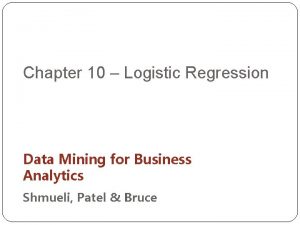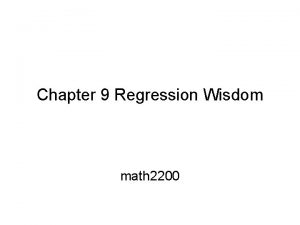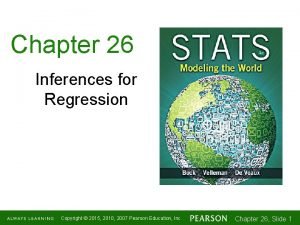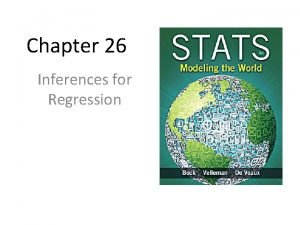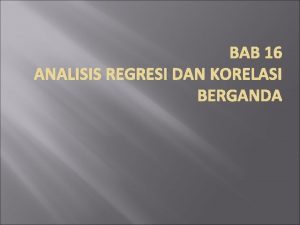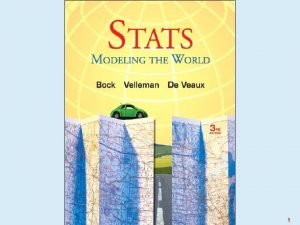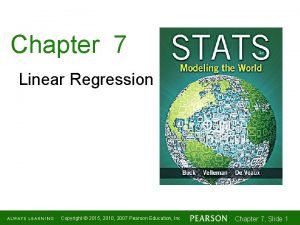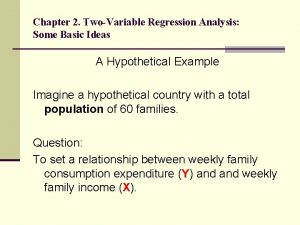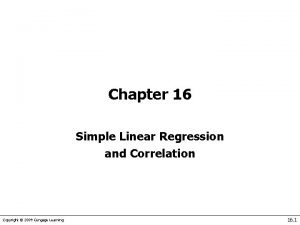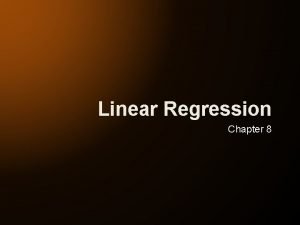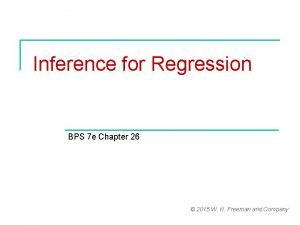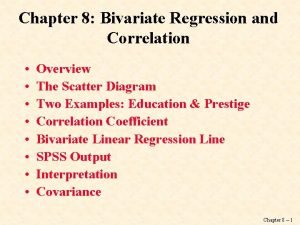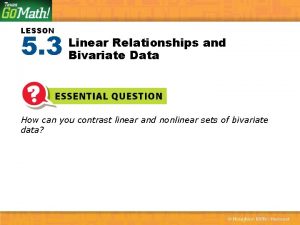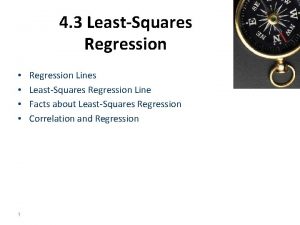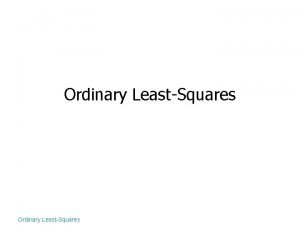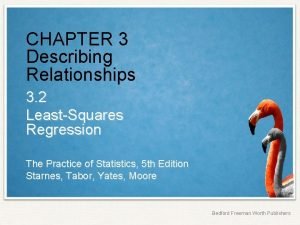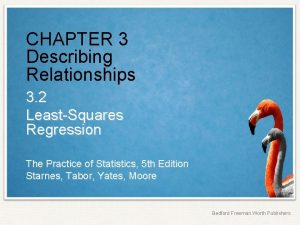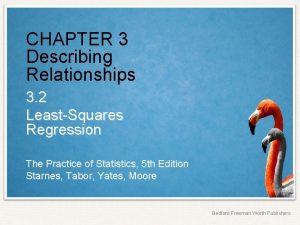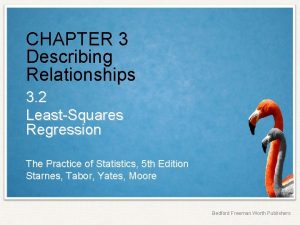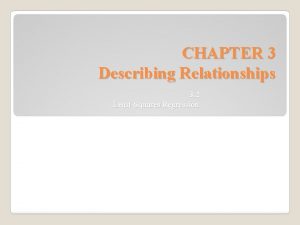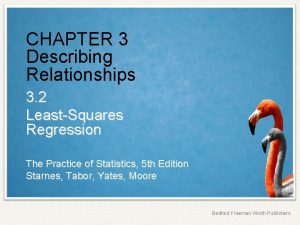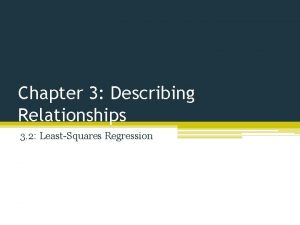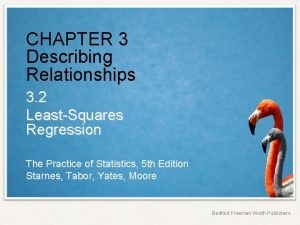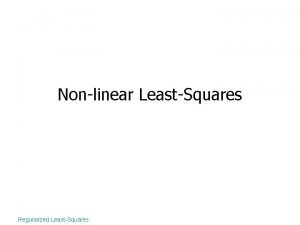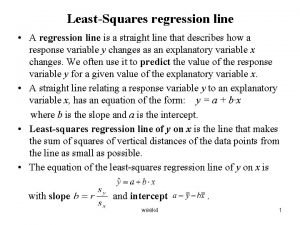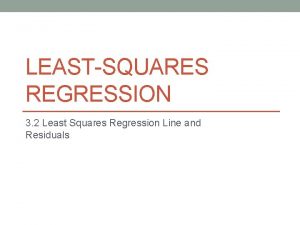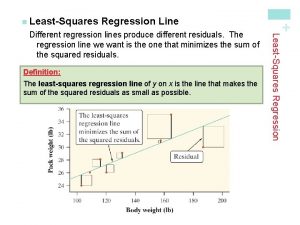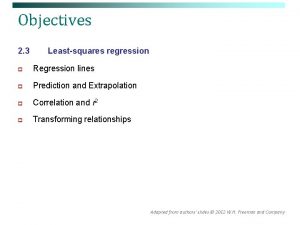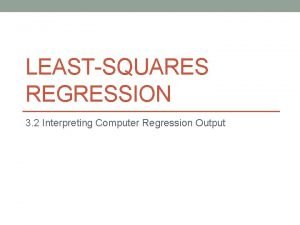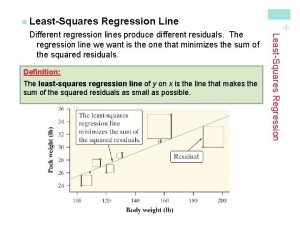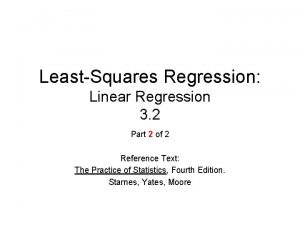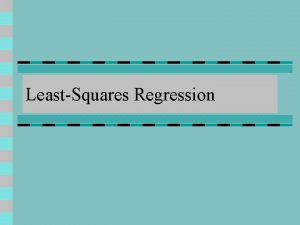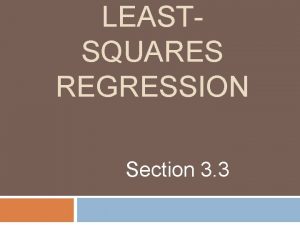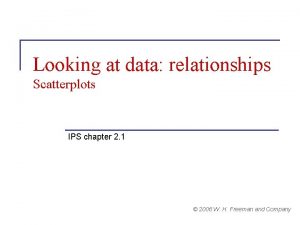Looking at data relationships Leastsquares regression IPS chapter























- Slides: 23

Looking at data: relationships Least-squares regression IPS chapter 2. 3 © 2006 W. H. Freeman and Company

Objectives (IPS chapter 2. 3) Least-squares regression p The regression line p Making predictions: interpolation p Coefficient of determination, r 2 p Transforming relationships

Correlation tells us about strength (scatter) and direction of the linear relationship between two quantitative variables. In addition, we would like to have a numerical description of how both variables vary together. For instance, is one variable increasing faster than the other one? And we would like to make predictions based on that numerical description. But which line best describes our data?

The regression line The least-squares regression line is the unique line such that the sum of the squared vertical (y) distances between the data points and the line is the smallest possible. Distances between the points and line are squared so all are positive values. This is done so that distances can be properly added (Pythagoras).

Properties The least-squares regression line can be shown to have this equation: is the predicted y value (y hat) b is the slope a is the y-intercept "a" is in units of y "b" is in units of y / units of x

How to: First we calculate the slope of the line, b; from statistics we already know: r is the correlation. sy is the standard deviation of the response variable y. sx is the standard deviation of the explanatory variable x. Once we know b, the slope, we can calculate a, the y-intercept: where x and y are the sample means of the x and y variables This means that we don't have to calculate a lot of squared distances to find the leastsquares regression line for a data set. We can instead rely on the equation. But typically, we use a 2 -var stats calculator or stats software.

BEWARE!!! Not all calculators and software use the same convention: Some use instead: Make sure you know what YOUR calculator gives you for a and b before you answer homework or exam questions.

Software output intercept slope R 2 r R 2 intercept slope

The equation completely describes the regression line. To plot the regression line you only need to plug two x values into the equation, get y, and draw the line that goes through those points. Hint: The regression line always passes through the mean of x and y. The points you use for drawing the regression line are derived from the equation. They are NOT points from your sample data (except by pure coincidence).

The distinction between explanatory and response variables is crucial in regression. If you exchange y for x in calculating the regression line, you will get the wrong line. Regression examines the distance of all points from the line in the ydirection only. Hubble telescope data about galaxies moving away from earth: These two lines are the two regression lines calculated either correctly (x = distance, y = velocity, solid line) or incorrectly (x = velocity, y = distance, dotted line).

Correlation versus regression The correlation is a measure In regression we examine of spread (scatter) in both the variation in the response x and y directions in the linear variable (y) given change in relationship. the explanatory variable (x).

Making predictions: interpolation The equation of the least-squares regression allows to predict y for any x within the range studied. This is called interpolating. Nobody in the study drank 6. 5 beers, but by finding the value of from the regression line for x = 6. 5 we would expect a blood alcohol content of 0. 094 mg/ml.

(in 1000’s) yˆ = 0. 125 x - 41. 4 � There is a positive linear relationship between the number of powerboats registered and the number of manatee deaths. The least squares regression line has the equation: yˆ = 0. 125 x - 41. 4 Thus if we were to limit the number of powerboat registrations to 500, 000, what could we expect for the number of manatee deaths? � Roughly 21 manatees.

Extrapolation This can be a very stupid thing to do, as seen here. Height in Inches Extrapolation is the use of a regression line for predictions outside the range of x values used to obtain the line. Height in Inches !!!

Example: Bacterial growth rate over time in closed cultures If you only observed bacterial growth in test-tube during a small subset of the time shown here, you could get almost any regression line imaginable. Extrapolation = big mistake.

The y intercept Sometimes the value of the y-intercept is not biologically possible. Here we have negative blood alcohol content, which makes no sense… But the negative value is appropriate for the equation of the regression line. There is a lot of scatter in the data, and the line is just an estimate. y-intercept shows negative blood alcohol

Coefficient of determination, r 2, the coefficient of determination, is the square of the correlation coefficient. r 2 represents the percentage of the variance in y (vertical scatter from the regression line) that can be explained by changes in x.

r = -1 r 2 = 1 Changes in x explain 100% of the variations in y. r = 0. 87 r 2 = 0. 76 Y can be entirely predicted for any given value of x. r=0 r 2 = 0 Changes in x explain 0% of the variations in y. The value(s) y takes is (are) entirely independent of what value x takes. Here the change in x only explains 76% of the change in y. The rest of the change in y (the vertical scatter, shown as red arrows) must be explained by something other than x.

r =0. 7 r 2 =0. 49 There is quite some variation in BAC for the same number of beers drunk. A person’s blood volume is a factor in the equation that was overlooked here. We changed number of beers to number of beers/weight of person in lb. r =0. 9 r 2 =0. 81 §In the first plot, number of beers only explains 49% of the variation in blood alcohol content. §But number of beers / weight explains 81% of the variation in blood alcohol content. §Additional factors contribute to variations in BAC among individuals (like maybe some genetic ability to process alcohol).

Grade performance If class attendance explains 16% of the variation in grades, what is the correlation between percent of classes attended and grade? 1. We need to make an assumption: attendance and grades are positively correlated. So r will be positive too. 2. r 2 = 0. 16, so r = +√ 0. 16 = + 0. 4 A weak correlation.

Transforming relationships A scatterplot might show a clear relationship between two quantitative variables, but issues of influential points or non linearity prevent us from using correlation and regression tools. Transforming the data – changing the scale in which one or both of the variables are expressed – can make the shape of the relationship linear in some cases. Example: Patterns of growth are often exponential, at least in their initial phase. Changing the response variable y into log(y) or ln(y) will transform the pattern from an upward-curved exponential to a straight line.

Exponential bacterial growth In ideal environments, bacteria multiply through binary fission. The number of bacteria can double every 20 minutes in that way. 1 - 2 - 4 - 8 - 16 - 32 - 64 - … log(2 n) = n*log(2) ≈ 0. 3 n Exponential growth 2 n, Taking the log changes the growth not suitable for regression. pattern into a straight line.

Body weight and brain weight in 96 mammal species r = 0. 86, but this is misleading. The elephant is an influential point. Most mammals are very small in comparison. Without this point, r = 0. 50 only. Now we plot the log of brain weight against the log of body weight. The pattern is linear, with r = 0. 96. The vertical scatter is homogenous → good for predictions of brain weight from body weight (in the log scale).
 Identity management looking out looking in
Identity management looking out looking in Looking out looking in chapter 9
Looking out looking in chapter 9 Simple and multiple linear regression
Simple and multiple linear regression Multiple regression vs linear regression
Multiple regression vs linear regression Survival analysis vs logistic regression
Survival analysis vs logistic regression Logistic regression vs linear regression
Logistic regression vs linear regression Logistic regression in data mining
Logistic regression in data mining Chapter 9 regression wisdom
Chapter 9 regression wisdom Chapter 26 inferences for regression
Chapter 26 inferences for regression Chapter 26 inferences for regression
Chapter 26 inferences for regression Worthless regression chapter 16
Worthless regression chapter 16 Chapter 27: inferences for regression
Chapter 27: inferences for regression Chapter 7 linear regression
Chapter 7 linear regression Srf and prf in econometrics
Srf and prf in econometrics Useless regression chapter 16
Useless regression chapter 16 Chapter 8 linear regression
Chapter 8 linear regression Chapter 26 inferences for regression
Chapter 26 inferences for regression Chapter 8 linear regression
Chapter 8 linear regression 5.3 linear relationships and bivariate data
5.3 linear relationships and bivariate data Modelling relationships and trends in data
Modelling relationships and trends in data Glencoe health chapter 7
Glencoe health chapter 7 Chapter 8 peer relationships answer key
Chapter 8 peer relationships answer key Chapter 7 family relationships
Chapter 7 family relationships Principles of ecology section 2 flow of energy
Principles of ecology section 2 flow of energy






